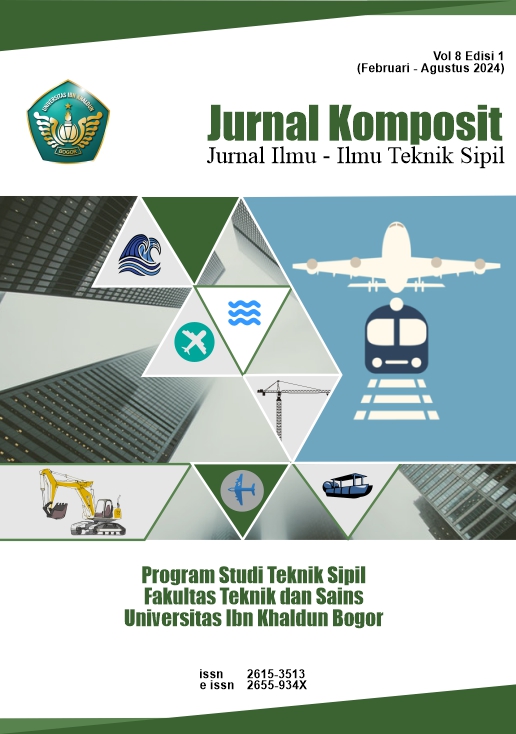Analisis Biaya pada Implementasi Resource Leveling Tenaga Kerja
DOI:
https://doi.org/10.32832/komposit.v8i1.14519Keywords:
Manpower, Resource Leveling, Resource AllocationAbstract
Construction projects are complex jobs within a certain period of time involving many resources such as materials, machines, methods, money, and manpower. Manpower is one of the resources with limited supply, high cost, and often causes problems due to fluctuations. Manpower needs to be analyzed for costs and distribution using the resource leveling method with the help of software in order to obtain the most efficient results. Manpower analysis was conducted under planning conditions, real implementation in the field, and after leveling. Labor allocation at planning (120 days) produced a graph with sharp fluctuations. There is a manpower allocation that exceeds the maximum capacity of daily manpower, making it inefficient. The highest manpower allocation was 167 workers/day, 9 masons/day, 43 carpenters/day, and 35 ironworkers/day at a total cost of Rp1,015,560,000. Meanwhile, the conditions in the field (120 days) equated to a daily manpower requirement of 55 workers/day, 4 masons/day, 16 carpenters/day, and 14 ironworkers/day at a total cost of Rp1,149,600,000. Meanwhile, the allocation of manpower must also take into account the type and volume of work to be completed. Furthermore, based on the results of the resource leveling study (144 days), a labor allocation with a low fluctuation graph was obtained. The allocation of labor is well distributed and no one exceeds the maximum capacity of daily manpower so that it is more efficient. It takes a total labor cost of Rp1,015,920,000. The comparative results of the three conditions have significant disparities. Labor after leveling results in the most efficient allocation. Meanwhile, labor before leveling results in the most efficient cost.
Key words: Resource Allocation, Resource Leveling, Manpower Cost.
References
Adianto, Y. L. D. & Putro, D. L. (2007) Analisis Resources Leveling Tenaga Kerja, Jurnal Teknik Sipil, 3(2), pp. 113–126.
Buya, M. & Ashad, H. (2022) Analisis Faktor Keterlambatan Waktu Pelaksanaan Konstruksi pada Pembagunan Kantor Bupati Pulau Taliabu dengan Metode Analytic Hierarchy Process, Jurnal Konstruksi: Teknik, Infrastruktur dan Sains, 1(1), pp. 44–53.
Astuti, R.D., Chayati, N. and Taqwa, F. M. L., (2018). Pengendalian Waktu Proyek pada Pembangunan Atap Stadion Renang Aquatic Senayan dengan Metode CPM. Prosiding Seminar Nasional Pascasarjana, Departemen Teknik Sipil Universitas Indonesia. pp.383-391.
Febriana, W. & Aziz, U.A. (2021). Analisis Penjadwalan Proyek dengan Metode PERT Menggunakan Microsoft Project 2016, Surya Beton: Jurnal Ilmu Teknik Sipil, 5(1), pp. 37–45.
Ismael, I. (2013). Keterlambatan Proyek Konstruksi Gedung Faktor Penyebab dan Tindakan Pencegahannya, Jurnal Momentum, 14(1).
Isnubroto, D. & Putri, C. K. (2021). Analisis Penjadwalan dan Alokasi Sumber Daya pada Proyek Konstruksi Menggunakan Microsoft Project (Studi Kasus Pekerjaan Struktur Proyek XYZ), Wahana Teknik Sipil: Jurnal Pengembangan Teknik Sipil, 26(1), pp. 52–65.
Malifa, Y., Dundu, A. K. T. & Malingkas, G. Y. (2019). Analisis Percepatan Waktu dan Biaya Proyek Konstruksi Menggunakan Metode Crashing (Studi Kasus: Pembangunan Rusun IAIN Manado), Jurnal Sipil Statik, 7(6).
Muzdalifah, L. et al. (2019). Penjadwalan Proyek Perumahan dengan Optimasi Waktu dan Biaya Harian, Jurnal Riset dan Aplikasi Matematika (JRAM), 3(2), pp. 78–88.
Nangka, C. I. G., Sibi, M. & Mangare, J. B. (2018). Perataan Tenaga Kerja pada Proyek Bangunan dengan Menggunakan Microsoft Project (Studi Kasus: Proyek Pembangunan Terminal Akap Tangkoko Bitung), Jurnal Sipil Statik, 6(11).
Retno, D. P., Astuti, A. & Tamimi, Z. (2018) Analisa Penggunaan Sumber Daya Manusia dengan Metode Resource Leveling pada Pelaksanaan Proyek Konstruksi (Studi Kasus: Proyek Pembangunan Ruang Kelas Baru Ponpes Daarun Nahdah Thawalib Bangkinang), Jurnal Saintis, 18(1), pp. 39–47.
Siswanto, A. B. & Salim, M. A. (2019) Manajemen Proyek. CV. Pilar Nusantara.
Sugiharto, R. (2020). Analisis Faktor-Faktor Dominan Manajemen Risiko terhadap Kinerja Keuangan Proyek Tahap Konstruksi, Jurnal Teknik Sipil Dan Lingkungan Universitas Nusa Putra (J-Teslink), 1, pp. 1–11.
Suputra, I. G. N. O. (2011). Penjadwalan Proyek dengan Precedence Diagram Method (PDM) dan Ranked Position Weight Method (RPWM), Jurnal Ilmiah Teknik Sipil Vol, 15(1).
Tengker, A. L., Dundu, A. K. T. & Walangitan, D. R. O. (2019). Perataan Tenaga Kerja dengan Menggunakan Microsoft Project pada Proyek Rehabilitasi Puskesmas Minanga, Jurnal Sipil Statik, 7(10).
Ulfa, R. (2021) Variabel Penelitian dalam Penelitian Pendidikan, Al-Fathonah, 1(1), pp. 342–351.
Waluyo, R. dan Aditama, S. (2017) Pengaruh Resource Leveling terhadap Alokasi Tenaga Kerja pada Proyek Konstruksi, Jurnal Ilmiah Teknik Sipil, 21(2), pp. 118–128.
Yani, V., Chandra, A., & Nugraha, P. (2015) Penerapan Resource Allocation dan Levelling Tenaga Kerja dengan Menggunakan Microsoft Project 2010 pada Suatu Proyek Konstruksi, Jurnal Dimensi Pratama Teknik Sipil, 4(1).
Downloads
Published
How to Cite
Issue
Section
License
Copyright (c) 2023 Jurnal Komposit: Jurnal Ilmu-ilmu Teknik Sipil

This work is licensed under a Creative Commons Attribution-NonCommercial-ShareAlike 4.0 International License.
Authors who publish with this journal agree to the following terms (Penulis yang mengajukan publikasi artikel telah menyetujui hal berikut):
- Through this publication, the author agree to submit the copyright of article writing to Jurnal Komposit: Jurnal Ilmu-ilmu Teknik Sipil. This copyright submission takes the form of, but is not limited to: reproduction of the article and parts therein, including photographic reproductions; distribution of articles through printed and electronic documents; and translation of articles(Bahwa melalui publikasi ini, hak cipta penulisan artikel diserahkan kepada Jurnal Komposit: Jurnal Ilmu-ilmu Teknik Sipil. Penyerahan hak cipta ini berupa, namun tidak terbatas pada: perbanyakan artikel dan bagian di dalamnya, termasuk reproduksi fotografi; penyebarluasan artikel melalui dokumen cetak dan elektronik; serta penterjemahan artikel).
- The authors agree to the terms of the Copyright Notice, according to Creative Commons Attribution-NonCommercial-ShareAlike 4.0 International License., which will apply to this article if and when it is published by Jurnal Komposit: Jurnal Ilmu-ilmu Teknik Sipil. (Para penulis setuju dengan ketentuan Pemberitahuan Hak Cipta, sesuai dengan Lisensi Internasional Creative Commons Attribution-NonCommercial-ShareAlike 4.0., yang akan berlaku untuk artikel ini jika dan ketika diterbitkan oleh Jurnal Komposit: Jurnal Ilmu-ilmu Teknik Sipil).

This work is licensed under a Creative Commons Attribution-NonCommercial-ShareAlike 4.0 International License.



.png)










